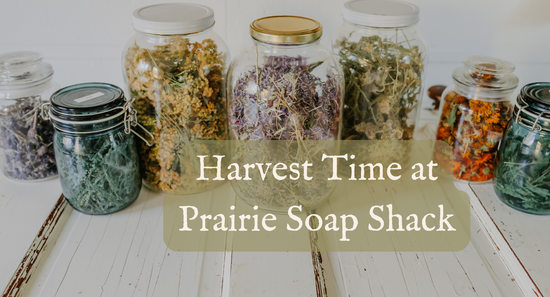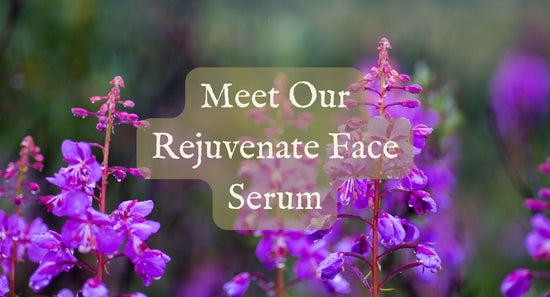This year marks year 7 of having my own vegetable, herb, and flower garden. I dabbled with a few planted pots for years prior to this and grew up helping my parents and grandparents with their gardens. Albeit I wasn’t much of a weeder, but more of a “help myself to the peas”, play hide and seek in the corn stalks or squish the potato bugs. Now that I have my own children, I know this is a great way to have the kids start their own bud of gardening interest by allowing them to play in the garden too- which I will address in each blog post about involving kids.
This blog series is divided into three parts sharing my own experience so far in my gardening journey. I live in zone 3b in central Alberta and recognize I will be learning new tricks and information each year, but I am also not a total beginner anymore so I hope you enjoy my point of view as gardening has brought me so much joy! I use my garden produce to feed my family as well as create products for Prairie Soap Shack, the possibilities are so much fun!
Part 1 will be about starting a garden and permaculture practices (click here to read).
Part 2 will be about seed starting, direct sowing and planting methods HERE
Part 3 will focus on tending to your garden and harvesting (Click here to read)
Part 2 - Seed starting, direct sowing and planting methods, Prairie Seeding
First of all, find out what gardening zone you live in. This determines the plant hardiness where you live. It tells you what you are able to grow, when you can plant and chance of survival over winter for perennials. I live Southeast of Red Deer in central Alberta and are zone 3b. I can’t typically transplant plants to the garden until the ground is warmed and the risk of frost is gone- almost always after May long weekend, maybe not even until the first week of June. This means my growing season is relatively short, as we can have frost as early as September.

To extend my growing season and have plants blooming earlier or bearing fruit sooner, I can start certain seeds indoors ahead of time.
Basically you have these options:
- Start seeds indoors that require growing time longer than 90 days
- Buy established plants at greenhouses in May
- Direct sow seeds that have shorter grow times
Or do all three options!
To figure out which plants should be started ahead of time and which ones should be direct sowed into your garden, you need to read the seed packets. Of course some plants can be done both ways but it just depends what becomes your preference.
From what I grow- the seeds that I start indoors ahead of time are tomatoes, peppers, eucalyptus, lavender, lemon balm, kale, rosemary, echinacea, watermelon, pumpkins, celery and calendula. I start some of these as early as February and my kids love to help. There’s something about watching seeds germinate, and hoping for spring that really gets you through the last of winter.
Seeds that I will direct-sow into the soil outside are carrot, beet, pea, pole beans, leafy greens like lettuce and spinach, corn, radish, rutabaga, zucchini, cucumber, onion bulbs and potato pieces.
I will likely do my prairie seeding the last week of May- with some seeds sooner that can tolerate cooler temperatures such as peas, spinach and potatoes. I will transplant my plants the first week of June usually- keeping an eye on those overnight low temperatures! First I will harden off my plants- by setting them outside during the day and taking them back into my greenhouse at night to help ease them into the weather. This can be done slowly over a few weeks to help toughen up the plants. Then ensuring the soil temp is also warm enough- around 15 celsius during the day. This is a benefit of raised garden beds as the soil will warm up faster than the ground. Then just gently loosen up the roots, water well and transplant into the garden bed.

But how to plant? The method I use and recommend is called “Square Foot Gardening”. You make a grid in your raised garden bed to be square feet- so in my 8x4 ft beds, I have 32 squares to plant! This is high density planting where you can companion plant to help mutually benefit plants as well as reduce the space for weeds to grow. I use the “seeding square” tool which makes it so easy to plant! For example, in one square foot I can fit 16 carrot plants (seed into 16 holes), or 9 spinach plants, 4 stalks of corn or one tomato plant. This tool also made it so easy for my young kids to help plant.

I like to do a mixture of vegetables, herbs and flowers together in my garden - because that is what makes my heart happy! I have staples of what I like to plant but each year, I like to try new plants and make a new decision with crop rotation (also a must each year).

I also like to have a few pot containers for each of my kids so they can plant whatever they like. Last year, they each planted rainbow carrots, snap peas and flowers of their favourite colours. I hope I am planting seeds of skills for them to use in their own lives one day.
Order your organic seeds from West Coast Seeds here.
Continue reading part 3 HERE on tending to your garden and harvesting.





